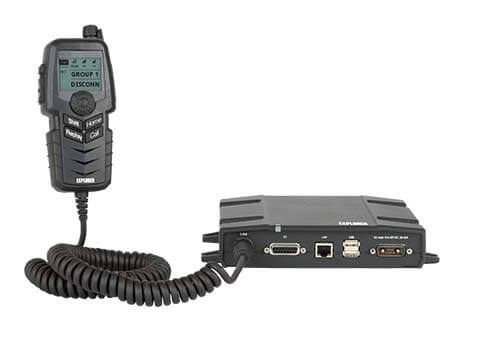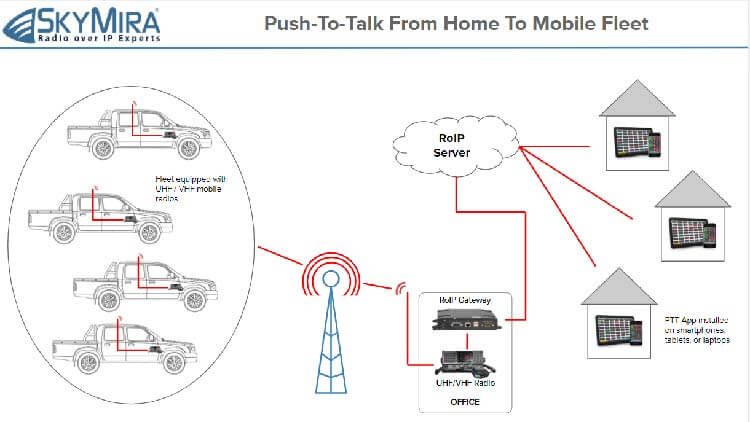RADIO OVER IP
The Basics
In a nutshell, RoIP is push-to-talk (PTT) communications over the internet. RoIP stands for radio over internet protocol (IP) which simply means the radio signals are transmitted via internet connections over satellite, LTE, or private networks.
RoIP enables reliable radio communication without gaps and dead zones even during disasters. RoIP also means PTT is no longer limited to traditional land mobile radios (LMRs), but can integrate modern devices such as smartphones, tablets, and PCs with traditional radios to make one unified network.
With RoIP, you can maintain the rugged simplicity of PTT while addressing the common problems commercial PTT users face by eliminating gaps, enabling remote connections, integrating modern devices, and protecting against outages and disasters.
Get Real Answers
Not sure if RoIP will meet your requirements?
Ask our solutions engineers.
Range and Reliability
One of the main drawbacks of PTT has been its dependence on infrastructure subject to spatial limitations and natural disasters. Radio signals have a short range and are easily blocked limiting how far users can go and leading to coverage gaps. Even where there’s good coverage, hurricanes, tornadoes, attacks, and other disasters can take radio towers down and knock out entire communication networks.
RoIP changes all of that because it does not rely on radio towers. By converting radio signals and transmitting them over IP networks, RoIP gives PTT networks the infinite range of satellites and other IP connections so that your teams and communications will never go off-grid again. This redundancy effectively eliminates the risk of losing connection and allows users to maintain instant, mission-critical communication anywhere in the world. It also means remote workers can PTT from anywhere.
This resilience and the freedom to go beyond line-of-sight make continuous communication possible even in conventionally challenging applications including outside of traditional radio coverage bands, inside of large buildings, and in disaster zones.
RoIP gateways allow you to exponentially increase your PTT network without building expensive ground infrastructure. With the range and reliability of radio over IP, your communication network is always there for you – especially when you need it most.
Interoperability
Another huge improvement with RoIP is its amazing interoperability. Traditional radios are limited in terms of the devices, brands, and bandwidths they can communicate with.
RoIP is interoperable with major brands (including Motorola, Kenwood, Harris, Bendix King, Tait, and others) and allows seamless communication between modern and legacy devices across bandwidths and groups. Vocality RoIP makes multiple radios interoperable to provide a seamless connection.
RoIP creates new possibilities for PTT communication by integrating internet-connected devices such as smartphones, tablets, PCs, VoIP phones, dispatch consoles, and others into traditional LMR networks. With remote work here to stay, this becomes even more critical as it enables remote workers to PTT with existing LMR networks using smartphones, tablets, laptops, and other traditional and non-traditional devices. This interoperability turns otherwise disparate systems into a unified PTT network.
Another huge improvement with RoIP is its amazing interoperability. Traditional radios are limited in terms of the devices, brands, and bandwidths they can communicate with.
RoIP is interoperable with major brands (including Motorola, Bendix King, Kenwood, Tait, and others) and allows seamless communication between modern and legacy devices across bandwidths and groups. Vocality RoIP makes multiple radios interoperable to provide a seamless connection.
RoIP creates new possibilities for PTT communication by integrating internet-connected devices such as smartphones, tablets, PCs, VoIP phones, dispatch consoles, and others into traditional PTT networks. With remote work here to stay, this becomes even more critical as it enables remote workers to PTT with existing LMR networks using smartphones, tablets, laptops, and other traditional and non-traditional devices. This interoperability turns otherwise disparate systems into a unified PTT network.
Flexibility
Because of its interoperability and range, RoIP is almost endlessly flexible. Whether you need mobile RoIP for use in vehicles, portable RoIP for teams on the go, fixed site RoIP for buildings and job sites, or a combination, there are simple and rugged solutions to match your operational needs. By integrating RoIP into your LMR network and choosing the RoIP solutions that match your workflow, you give yourself the ultimate flexibility to boldly face the new future with its inevitable surprises and challenges while increasing efficiency and performance.
Scalability
The range, interoperability, and flexibility of RoIP means it is incredibly scalable to meet your current and future needs. By studying your workflow, Skymira takes a tailored approach to help you get just what you need. Then, over time, your RoIP network can grow with you as you seamlessly integrate new equipment and applications.
Remote PTT
Increasingly, businesses and agencies need a way to enable remote workers to PTT. Remote work is here to stay, and RoIP makes remote PTT possible. RoIP not only makes it possible for remote workers to stay in touch using mobile and portable radios, it enables them to PTT with existing LMR networks using smartphones, tablets, and laptops. This completely changes the game for remote dispatchers, office personnel, emergency and disaster teams, and others. By enabling remote PTT, RoIP allows remote teams to continue to take advantage of the simplicity and durability of PTT.
Common Misconceptions
The most common misconceptions about RoIP relate to affordability and latency. While historically there have been some issues on these important points, modern RoIP passes both of these tests with flying colors.
AFFORDABILITY
RoIP is the most affordable and reliable critical communications system available. RoIP technology and equipment have become more affordable in recent years, and new satellite solutions with very competitive flat rates make budgeting and analysis simple.
Because RoIP systems are built rugged and durable for real-work applications, RoIP networks have reduced lifecycle costs. Also, since RoIP doesn’t require you to replace all of your radios and network equipment, it is a very affordable way to update your network and solve communication problems without having to start over. Retaining familiar devices eliminates the need for extensive training and reprogramming with the associated costs in time and production.
LATENCY
Using RoIP you’ll be getting clear voice and uninterrupted data connectivity in even the most remote locations with latency on par with 5G.
Where to Start
The first step toward achieving the reliable flexibility of RoIP is to evaluate your needs and workflow. By studying your processes, Skymira is able to make recommendations for how to tailor RoIP solutions to meet your needs. Our RoIP and workflow experts make this part easy.
If you would like to begin this process or have questions about RoIP, contact a Skymira RoIP expert today.
Tailored Solutions
Need a tailored RoIP solution for your application?
Connect with our solutions engineers.
Check out Google’s #1 ranking post on RoIP

Radio over Internet Protocol (RoIP) uses similar technology as Voice over IP (VoIP), except that RoIP sends push-to-talk (PTT) voice communications over the internet. The benefits of RoIP solutions fall into one of the following four categories: larger service area, greater reliability, more base station users, and increased disaster-resilience.
FAQ
Q: What can RoIP be used for?
A: RoIP can be used for any commercial PTT application and unifies all of your communication networks into one system. It’s especially useful for:
- gaining broader coverage
- getting rid of network gaps
- ensuring greater reliability
- enabling remote users to stay in touch using PTT
- integrating smartphones, tablets, PCs, VoIP phones, workstations, and other internet-enabled, modern devices
- allowing users to monitor or manage more than one channel or group at a time
- eliminating interference for computer-based users
- connecting third parties and inter-agency groups
Our clients love the way RoIP connects remote teams, creates smooth communication between front office staff and other personnel, and allows inter-group coordination.
Q: What is RoIP?
A: Radio over Internet Protocol (RoIP) is a technology that allows two-way radio communications to be transmitted over an IP network, such as the Internet. This is in contrast to traditional two-way radio systems, which use radio waves to transmit communications. RoIP solutions work by converting radio signals into digital packets, which are then transmitted over the IP network. The packets are then decoded and converted back into radio signals at the receiving end. The use of an IP network for radio over IP allows users to communicate over greater distances and with more people than traditional two-way radio systems.
Q: Who is using RoIP?
A: RoIP provides resilient and unified field communication for commercial and government PTT applications. With the rapid evolution of remote work, RoIP has become even more critical for businesses and government agencies using PTT such as:
- energy utilities
- transportation
- manufacturing
- wildland fire
- first response
- law enforcement
- and others
We’ve helped everyone from barge transport companies to energy utilities and steel plants to federal agency teams solidify communication and eliminate common problems with RoIP. If you have a team using PTT, RoIP can eliminate gaps, integrate modern devices, and protect against downtime.
Q: Do you have to replace all devices on your network?
A: No. RoIP is incredibly interoperable and is compatible with most brands including Motorola, Kenwood, Harris, BK, Tait, and others. This means that the RoIP gateways and devices will integrate seamlessly into your existing PTT network.
Q: Do you have to get all of these RoIP devices?
Q: How much training is needed?
Q: How often does RoIP technology need to be replaced?
Q: Why Skymira?
A: Skymira’s RoIP experts excel at creating a tailored RoIP strategy that matches your operational workflow. This means you will receive maximum benefit with minimal adjustment and cost. With our expert service team, large portfolio of high-quality hardware, and access to satellite, LTE, and FirstNet networks, we make it easy for you to benefit from the incredible reliability, flexibility, and interoperability of RoIP.
Want to learn more about RoIP and how it can help you achieve your operational goals? Contact a Skymira expert today.





